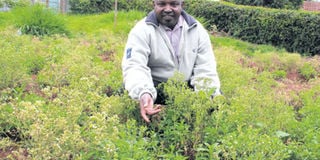Stevia sweetens farmers’ lives with handsome rewards

Mr Samuel Karanja, a stevia farmer at Thunguma Village in Nyeri, tends to the crop. PHOTO | JOSEPH KANYI | NATION MEDIA GROUP
What you need to know:
- Karanja is a former teacher and a coffee farmer, while his colleagues mainly sell stevia seedlings to farmers in Nyahururu, Murang’a, Kiambu and Nyeri.
- Undeterred, the group bought and planted another 50,000 seedlings. The crops did well and produced seeds with which they started propagating seedlings in greenhouses.
- The plant’s leaves are used as a sweetener since they have sweet crystalline glycosides called steviosides, which are 200 to 300 times sweeter than sucrose.
The eight-acre farm in Nyeri is divided into two parts of about the same size.
The bigger portion has coffee stems while the other stevia (stevia rebaudiana bertoni), a crop that is fast gaining popularity in central Kenya.
“We have more than 50,000 plants on this farm,” says Samuel Karanja, the coordinator of Special Crop Farmers group.
The over 20 members of the group are growing it in the coffee-dominated region to supplement their incomes.
Karanja is a former teacher and a coffee farmer, while his colleagues mainly sell stevia seedlings to farmers in Nyahururu, Murang’a, Kiambu and Nyeri.
“Stevia matures in about 60 days, but we sell the seedlings at Sh30 each when they are two to three weeks old.”
It has been a long journey for the group that started off more than two years ago.
They made several mistakes but eventually learned the proper way to grow the crop.
“We started by buying 70,000 cuttings at Sh5 each from members’ contributions. The crops, however, did not flourish,” says Karanja, on whose land the crops grow.
MEMBERS QUIT
The cuttings dried and some members quit the group because they felt discouraged.
“It was our mistake. The crops dried because we did not treat the cuttings in anti-fungal pesticide before planting.”
Undeterred, the group bought and planted another 50,000 seedlings. The crops did well and produced seeds with which they started propagating seedlings in greenhouses.
“We normally harvest stevia seeds from mature plants, place them in containers filled with soil and mix with an anti-fungal. The seeds are then put in the greenhouse and constantly watered using drip irrigation. After three weeks, they are transferred to the field.”
Alternatively, one can place moisturised soil in a black polythene paper and dry it in the sun. This kills harmful organisms.
“The soil is dried for three weeks and then the seeds are planted to germinate and mature to a seedling after three weeks.”
Most farmers, according to Karanja, prefer buying seedlings at Sh30 each since they can transfer them to the farm almost immediately.
For best results, stevia should be grown in areas with cool weather and strong sunlight. The crop, which is rarely attacked by pests and diseases, displays white flowers when nearing maturity.
NATURAL SWEETENER
Stevia is a natural sweetener, which belongs to the family compositae.
The plant’s leaves are used as a sweetener since they have sweet crystalline glycosides called steviosides, which are 200 to 300 times sweeter than sucrose. As a natural sweetener, stevia is healthy because it does not contain any calorie.
It is thus recommended for diabetics and used in the prevention of obesity because one gets the sweetness without gaining calories.
The group’s monthly income is between Sh200,000 to Sh240,000, which they share according to their contributions.
Jannath Bhagar, an agricultural consultant with Dedan Kimathi University, says stevia is mainly propagated through cuttings and seedlings.
If one opts for stevia seeds to get seedlings, they are first germinated in pots or bags and then transplanted to beds.
“Stevia thrives in sandy or loamy soils with good amount of compost manure. The soil should be acidic with a pH of 4 to 5,” she says.
Bhagar notes that after the seedling or cutting has been planted, the soil around the plant should be mulched to protect the shallow roots of the herb.
She says that farmers should harvest after three months to obtain the best quality. The herb’s branches should also be pruned 10cm from the ground.
“When the crop’s crushed leaves are concentrated, they can be sold as a dietary supplement and when raw, they can be cooked just like a regular herb and is a sweetener that can be blended with tea or coffee.”





